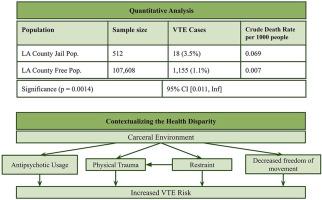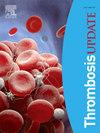Impacts of the carceral environment on autopsy-verified venous thromboembolism mortality
Q4 Medicine
引用次数: 0
Abstract
Venous thromboembolism (VTE), encompassing deep vein thrombosis and pulmonary embolism, is a leading cause of mortality globally, with increasing incidence in the United States. However, no studies have examined VTE risk factors in carceral settings. This study evaluates VTE-related deaths in jailed and non-jailed populations in Los Angeles County over 16 years (2008–2023). Using death records, we compiled two datasets: one for deaths in Los Angeles County jails (n = 512) and another for deaths in the free population (n = 107,608). VTE cases were identified through keyword searches and reviewed for diagnostic consistency. Statistical analyses compared mortality rates and demographics, and a qualitative review of jailed VTE decedent autopsy records was conducted to identify risk factors linked to incarceration. VTE-related deaths in the jailed population were over three times higher than in the free population (3.5 % vs. 1.1 %, p = 0.0014). Crude mortality rates in jails have risen since 2014, peaking in 2021. Black individuals, while comprising 7.9 % of the county population and 29.4 % of the jail population, accounted for 66.67 % of VTE deaths in jails, highlighting exacerbated racial disparities. Structural and environmental factors in carceral settings, including restricted mobility, antipsychotic medication use, and restraints, likely contribute to elevated risks. Improving restraint use reporting and post-mortem toxicology findings for pulmonary embolism deaths can enhance etiology understanding. Diversion programs for mental health populations and other decarceral approaches, alongside anticoagulant prescriptions, could mitigate VTE risks and reduce health inequities in incarcerated populations.

癌症环境对尸检证实的静脉血栓栓塞死亡率的影响
静脉血栓栓塞(VTE),包括深静脉血栓形成和肺栓塞,是全球死亡的主要原因,在美国发病率不断上升。然而,没有研究检查静脉血栓栓塞的危险因素在癌症环境。本研究评估了洛杉矶县16年间(2008-2023年)监狱和非监狱人口中与vte相关的死亡。使用死亡记录,我们编制了两个数据集:一个用于洛杉矶县监狱的死亡(n = 512),另一个用于自由人口的死亡(n = 107,608)。通过关键词搜索确定静脉血栓栓塞病例,并对诊断一致性进行审查。统计分析比较了死亡率和人口统计数据,并对被监禁的静脉血栓栓塞死者的尸检记录进行了定性审查,以确定与监禁有关的风险因素。被监禁人群中与静脉血栓栓塞相关的死亡率是自由人群的三倍多(3.5%对1.1%,p = 0.0014)。监狱中的粗死亡率自2014年以来一直在上升,并在2021年达到峰值。黑人虽然占该县人口的7.9%和监狱人口的29.4%,但占监狱中静脉血栓栓塞死亡人数的66.67%,突出表明种族差异加剧。监狱环境中的结构和环境因素,包括活动受限、抗精神病药物的使用和约束,可能导致风险升高。改善肺栓塞死亡的约束使用报告和尸检毒理学结果可以加强对病因学的了解。针对精神健康人群的分流计划和其他decaral方法,以及抗凝药物处方,可以降低静脉血栓栓塞的风险,减少监禁人群的健康不平等。
本文章由计算机程序翻译,如有差异,请以英文原文为准。
求助全文
约1分钟内获得全文
求助全文

 求助内容:
求助内容: 应助结果提醒方式:
应助结果提醒方式:


